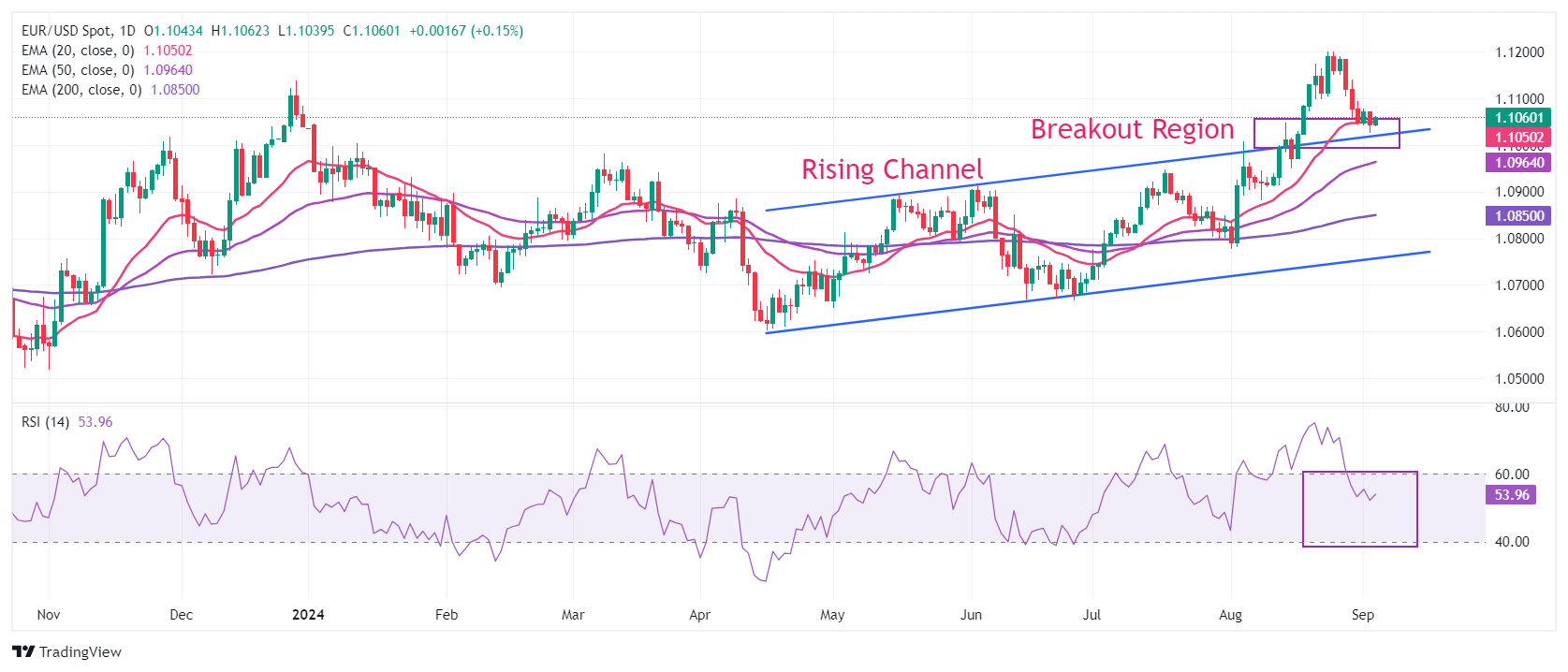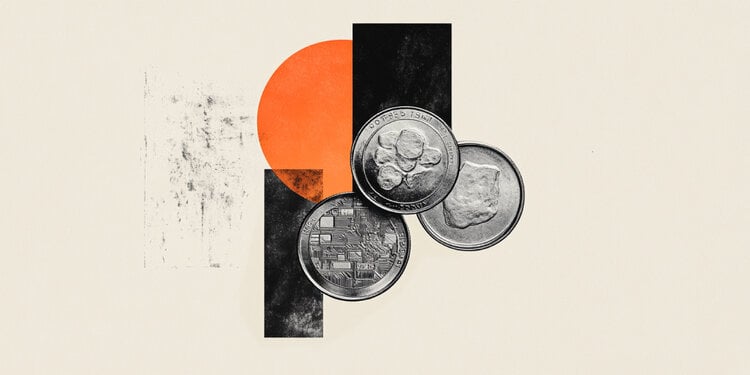- EUR/USD finds temporary support near 1.1030 amid a slight correction in the US Dollar.
- Dollar falls as US ISM manufacturing PMI data pointed to a contraction in activity for the fifth consecutive month.
- Investors are awaiting the US JOLTS job openings data for July.
EUR/USD sees buying interest in Wednesday’s European session after posting a fresh two-week low near 1.1025 on Tuesday. The major currency pair is higher as the US Dollar (USD) corrects following the release of the US ISM manufacturing PMI data for August. The US Dollar Index (DXY), which tracks the value of the Greenback against six major currencies, is down near 101.60 after failing to reclaim a two-week high of 102.00.
The ISM manufacturing PMI, released on Tuesday, came in at 47.2, below estimates of 47.5 but improving from an eight-month low of 46.8. Despite the slight improvement, markets took the view that the overall trend is toward a slowdown as a reading below 50.0 suggests a contraction in manufacturing activity.
In a data-heavy week, investors are eagerly awaiting the US Non-Farm Payrolls (NFP) data for August, due on Friday. The official labor market data will shape the Federal Reserve’s (Fed) path of interest rate cuts for September. Investors appear confident that the Fed will begin cutting its key interest rates this month, but are divided on the size of this potential rate cut.
The importance of labor market data has increased significantly following Fed Chairman Jerome Powell’s comments at the Jackson Hole (JH) Symposium, who noted that the central bank is very concerned about weakening labor demand.
For further insight into the current state of the labor market, investors will also be focusing on the US JOLTS job openings data for July and the ADP employment change data for August, due out at 14:00 GMT and on Thursday, respectively.
The U.S. JOLTS job openings report is expected to show that employers posted 8.1 million new job openings, down slightly from 8.184 million the previous month.
Market Movers: EUR/USD Rises as Dollar Corrects
- EUR/USD is recovering slightly in European trading hours amid a gradual correction in the US Dollar. The short-term outlook for the Euro (EUR) remains negative as market participants expect that the European Central Bank (ECB) policy easing cycle could be aggressive given the sharp decline in inflationary pressures in the Eurozone and weak economic growth.
- Bank of America (BofA) economists said in their latest Eurozone report: “We still see more cuts in 2025/26 than the market is pricing in, with a return to a 2% deposit rate by Q3 2025 at the latest and 1.5% in 2026.” BofA said Europe’s recovery remains fragile and is likely to be shallow, pressured by a number of economic factors such as slowing growth in China, as well as politics.
- ECB officials also remain concerned about rising risks to eurozone economic growth. ECB executive committee member Piero Cipollone said in an interview with a French newspaper that there is a real risk that our stance could become too restrictive, adding that, “We must ensure that inflation converges to our objective without unnecessarily slowing down the economy,” Reuters reported.
- On the economic front, investors are awaiting Eurozone retail sales data for July, due on Thursday. Economists estimate that retail sales have grown by 0.1% after contracting by 0.3% in June both on a monthly and annual basis. A slight improvement in sales at retail stores would be insufficient to dampen market speculation that the ECB will resume its policy easing cycle this month, which began in June, after a pause in July.
- In today’s session, investors will focus on the Eurozone Producer Price Index (PPI) data for July, due out at 09:00 GMT. The PPI report is expected to show that prices of goods and services at factory gates deflated at a slower pace of 2.5% from 3.2% in June. Strong deflation in producer prices indicates a sharp slowdown in overall demand. This would boost expectations for ECB rate cuts in September.
Technical Analysis: EUR/USD struggles for firm support near the 20-day EMA
EUR/USD rebounds slightly after posting a fresh two-week low near 1.1025. The near-term outlook for the major currency pair is uncertain as it struggles to find firm support near the 20-day exponential moving average (EMA) around 1.1020.
The long-term outlook remains bullish as the 50-day and 200-day EMAs at 1.0964 and 1.0850, respectively, are sloping upwards. Moreover, the shared currency pair is holding the breakout of the ascending channel on a daily time frame.
The 14-day Relative Strength Index (RSI) has fallen below 60.00 after turning overbought near 75.00.
On the upside, the recent high of 1.1200 and the July 2023 high of 1.1275 will be the next target for Euro bulls. Meanwhile, the downside is expected to remain cushioned near the psychological support of 1.1000.
Euro FAQs
The Euro is the currency of the 20 European Union countries that belong to the Eurozone. It is the second most traded currency in the world, behind the US Dollar. In 2022, it accounted for 31% of all foreign exchange transactions, with an average daily volume of over $2.2 trillion per day. EUR/USD is the most traded currency pair in the world, accounting for an estimated 30% of all transactions, followed by EUR/JPY (4%), EUR/GBP (3%) and EUR/AUD (2%).
The European Central Bank (ECB), based in Frankfurt, Germany, is the reserve bank of the Eurozone. The ECB sets interest rates and manages monetary policy. The ECB’s main mandate is to maintain price stability, which means controlling inflation or stimulating growth. Its main instrument is to raise or lower interest rates. Relatively high interest rates – or the expectation of higher rates – generally benefit the Euro and vice versa. The Governing Council of the ECB takes monetary policy decisions at meetings held eight times a year. Decisions are taken by the heads of the national banks of the Eurozone and six permanent members, including ECB President Christine Lagarde.
Eurozone inflation data, as measured by the Harmonised Index of Consumer Prices (HICP), is an important econometric data point for the euro. If inflation rises more than expected, especially if it exceeds the ECB’s 2% target, the ECB is forced to raise interest rates to bring inflation back under control. Relatively high interest rates compared to their peers usually benefit the euro, as it makes the region more attractive as a place for global investors to park their money.
Data releases measure the health of the economy and can influence the Euro. Indicators such as GDP, manufacturing and services PMIs, employment and consumer sentiment surveys can influence the direction of the single currency. A strong economy is good for the Euro. Not only does it attract more foreign investment, but it can encourage the ECB to raise interest rates, which will directly strengthen the Euro. Conversely, if economic data is weak, the Euro is likely to fall. Economic data from the four largest Eurozone economies (Germany, France, Italy and Spain) are especially significant, as they account for 75% of the Eurozone economy.
Another important output for the euro is the trade balance. This indicator measures the difference between what a country earns from its exports and what it spends on imports during a given period. If a country produces highly sought-after export products, its currency will appreciate due to the additional demand created by foreign buyers who wish to purchase these goods. Therefore, a positive net trade balance strengthens a currency and vice versa for a negative balance.
Source: Fx Street
I am Joshua Winder, a senior-level journalist and editor at World Stock Market. I specialize in covering news related to the stock market and economic trends. With more than 8 years of experience in this field, I have become an expert in financial reporting.








